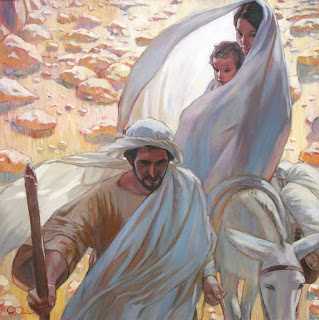Vishnu is among the most important deities of Hinduism. Along with Brahma and Shiva, Vishnu forms the principal trinity of Hindu religious practice.
In his many forms, Vishnu is regarded as the preserver and protector. Hinduism teaches that when humanity is threatened by chaos or evil, Vishnu will descend into the world in one of his incarnations to restore righteousness. Because there are so many avatars in Hinduism it is more difficult to keep track of which avatar belongs to who, but I'll do my best to keep everyone straight.
Jesus Christ has many avatars as well, though as a Christian they are more familiar and therefore perceived as more obvious
Jehovah: pre-mortal name of Jesus
Lion of Judah: Aslan
Avatars of Vishnu:
Krishna
According to Bhagavata Purana some believe that Krishna was born without a sexual union, by “mental transmission” from the mind of Vasudeva into the womb of Devaki, his mother.
Lord Rama is the seventh incarnation of Lord Vishnu. Lord Rama is said to have taken birth on earth to annihilate the evil forces of the age. He is always holding a bow and arrow indicating his readiness to destroy evils
Christ and Krishna were called both God and the Son of God. Both were sent from heaven to earth in the form of a man. Both were called Savior, and the second person of the Trinity. Krishna’s adoptive human father was also a carpenter. A spirit or ghost was their actual father. Krishna and Jesus were of royal descent. Both were visited at birth by wise men and shepherds, guided by a star. Angels in both cases issued a warning that the local dictator planned to kill the baby and had issued a decree for his assassination. The parents fled. Mary and Joseph stayed in Muturea; Krishna’s parents stayed in Mathura. Both Christ and Krishna withdrew to the wilderness as adults, and fasted. Both were identified as “the seed of the woman bruising the serpent’s head.” Jesus was called “the lion of the tribe of Judah.” Krishna was called “the lion of the tribe of Saki.” Both claimed: “I am the Resurrection.” Both were “without sin.” Both were god-men: being considered both human and divine. Both performed many miracles, including the healing of disease. One of the first miracles that both performed was to make a leper whole. Each cured “all manner of diseases.” Both cast out indwelling demons, and raised the dead. Both selected disciples to spread his teachings. Both were meek, and merciful. Both were criticized for associating with sinners. Both celebrated a last supper. Both forgave his enemies. Both were crucified and both were resurrected.
They relate how Krishna (literally “black,” or “dark as a cloud”) was born into the Yadava clan (House of David), the son of Vasudeva (God the Father) and Devaki (Mary), who was the sister of Kamsa (King Herod), the wicked king of Mathura. Mary wasn't Herod's sister, but she was a literal descendant of King David and she and her children would have legitimate claim on the kingdom of Israel). Kamsa (Herod), hearing a prophecy that he would be destroyed (the kingdom of Israel taken from him) by Devaki’s child, tried to slay her children (Matt 2:16, slaughter of the innocents), but Krishna was smuggled (Matt 2:13) across the Yamuna River to Gokula (or Vraja, modern Gokul), where he was raised by the leader of the cowherds, Nanda, and his wife Yashoda.
The child Krishna was adored for his mischievous pranks; he also performed many miracles and slew demons. As a youth, the cowherd Krishna became renowned as a lover, the sound of his flute prompting the gopis (wives and daughters of the cowherds) to leave their homes to dance ecstatically with him in the moonlight. His favourite among them was the beautiful Radha. At length, Krishna and his brother Balarama returned to Mathura to slay the wicked Kamsa. Afterward, finding the kingdom unsafe, Krishna led the Yadavas to the western coast of Kathiawar and established his court at Dvaraka (modern Dwarka, Gujarat). He married the princess Rukmini and took other wives as well.
Krishna refused to bear arms in the great war between the Kauravas (sons of Dhritarashtra, the descendant of Kuru) and the Pandavas (sons of Pandu), but he offered a choice of his personal attendance to one side and the loan of his army to the other. The Pandavas chose the former, and Krishna thus served as charioteer for Arjuna, one of the Pandava brothers. (This might be a story we don't have record for, of a conflict in Egypt while he was there).
On his return to Dvaraka, a brawl broke out one day among the Yadava chiefs in which Krishna’s brother (the familial tie is his cousin, John the Baptist) and son (John, having been born again, so to speak would have been considered spiritual offspring of Jesus Christ) were slain. As the god sat in the forest lamenting (Matthew 14:13, mourning the death of John and then sorrowing in the Garden of Gethsemane) , a huntsman, mistaking him for a deer (parable-like, where Roman soldiers thinking this is a legitimate arrest), shot him in his one vulnerable spot, the heel killing him. (Genesis 3:15, where God tells Adam and Eve that the Savior will bruise his heel while stepping on the head of the snake).
Parvati (Sanskrit: पार्वती, IAST: Pārvatī) or Uma (IAST: Umā) is the Hindu goddess of fertility (Mary?)
Flee into Egypt
Birth of Krishna - Vasudeva and Devaki Escaping from Prison
Running North to South there is the Port Said Ismailia River separating the land between Israel and Egypt. Fleeing into Egypt would have required a river crossing. There is no way around it.




